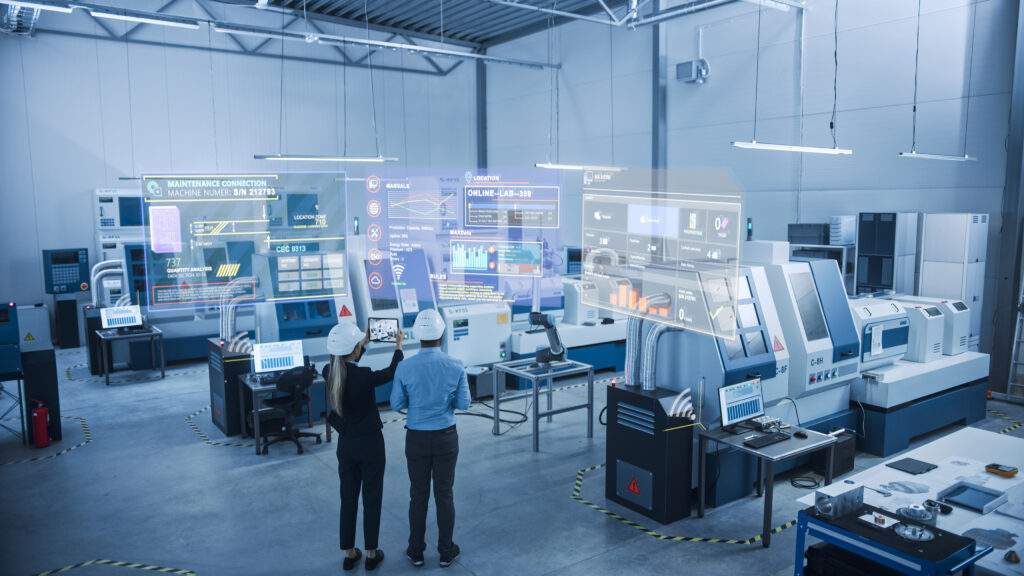
Claire Fallon, executive director of ISA, shares top automation trends for 2023
April 10, 2023
By Manufacturing AUTOMATION
Experts from the industrial automation space discuss technology trends that will impact manufacturers in 2023 and beyond.
 PHOTO: gorodenkoff / iStock / Getty Images Plus / Getty Images
PHOTO: gorodenkoff / iStock / Getty Images Plus / Getty Images Advances in automation technologies are transforming the industrial manufacturing landscape. Broadly termed “digital transformation,” these smart manufacturing initiatives bring physical and cyber systems together for greater performance, efficiency, sustainability and safety.
Automation experts share their predictions on trends that Canadian manufacturers need to watch out for in 2023 and respond to accordingly.
Here are the predictions for the year from Claire Fallon, executive director of the International Society of Automation (ISA).
1. Industrial connectivity and security
According to a recent research from Nokia and ABI Research, 74 percent of manufacturing decision makers surveyed have plans to upgrade or enhance their communications networks. In 2023, it should be expected that a substantial number of manufacturers will see the benefits of investing in a private 5G network to advance digital transformation and Industry 4.0.
One of the biggest challenges for these industrial connectivity upgrades, however, is the existence of operational technology (OT) legacy equipment that cannot easily be integrated, particularly at the state and municipal levels, or with smaller enterprises. This legacy equipment poses increased risk of cybersecurity threats. OT-specific security equipment and platforms are becoming increasingly prevalent in the market to address this challenge, but not all of these are created equal. For the greatest security and interoperability, asset owners should look for equipment that is compliant with recognized international standards like ISA/IEC 62443.
2. Artificial intelligence and machine learning
If you’ve marvelled at how quickly TikTok got to know that you like content about pop culture and cooking, then you have an AI-driven algorithm to thank. But understanding customer and industry trends is just one piece of what AI can do. In the coming years, we will see more manufacturers leveraging AI and machine learning to better identify process bottlenecks and opportunities for cost savings through process automation.
Adding AI technology to industrial automation environments can increase system flexibility and functionality. Additionally, AI has the potential to make advancements in greater workplace safety and efficiency by mitigating repetitive and dangerous tasks or conducting preventive maintenance analysis. Manufacturers who adopt this technology stand to position themselves as next-gen leaders in data-driven manufacturing.
3. Digital twin and simulation
In the coming years, manufacturers looking to increase the productivity of their manufacturing systems will embrace the evolving opportunity of the digital twin. Similar to the previous example of using machine learning for preventive maintenance, the digital twin is the notion of building a functional digital simulation version of a physical asset.
Using the digital twin, a company can collect machine data and feed it into a model that can simulate future operations, determine failure limits, plan maintenance activities, and even calculate how much longer the machine will be operational – all without the physical machine being stopped. Adoption of digital twins opens the door for manufacturers to be flexible and adapt manufacturing processes to fluctuating supply chains, market demands, and more.
4. Virtualization technologies
You have probably heard of AR and VR in relation to video games, but in a manufacturing context, virtualization is no game. In the case of AR, or augmented reality, we expect to see an increase in the use of smart glasses to serve up machine and system information to operators. Using VR, or virtual reality, operators can prepare for dangerous situations or train on remote equipment and facilities. The two scenarios can even interoperate: imagine an operator in the field wearing smart glasses (AR), which transmit visualization and data to a remote technician working in a virtual environment (VR). Virtualization technologies unlock a new level of knowledge and innovation in the automation and manufacturing industries.
5. Cloud and edge computing
Cloud computing – where data is stored and processed remotely – is familiar to most manufacturers at this point. Edge computing refers to scenarios between the cloud and the device like real-time data processing for important smart factory applications like predictive maintenance. Going into 2023, a stronger reliance upon the hybrid cloud model, where proprietary internal process information is stored locally by manufacturers, and resource-intensive applications like machine learning are moved to the public cloud will be trending.
Cloud-based operations, however, face omnipresent cybersecurity threats. Leveraging robust cybersecurity policies, such as the ISA/IEC 62443 standards, combined with regular audits and updates is key to maintaining a secure cloud or edge computing-based manufacturing operation.
 Claire Fallon is executive director of the International Society of Automation (ISA). A mechanical engineer by training, Fallon previously worked as a design engineer for Bechtel and served on the board of the American National Standards Institute (ANSI) and appeals board for Underwriters Laboratories (UL).
Claire Fallon is executive director of the International Society of Automation (ISA). A mechanical engineer by training, Fallon previously worked as a design engineer for Bechtel and served on the board of the American National Standards Institute (ANSI) and appeals board for Underwriters Laboratories (UL).
Advertisement
- AI robotics company Covariant receives $75M in Series C funding
- RS Group and Hammond Manufacturing partner to offer custom electrical and electronic enclosures